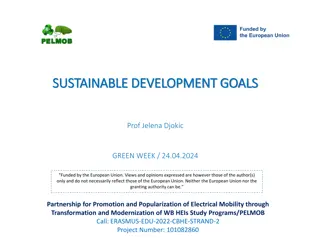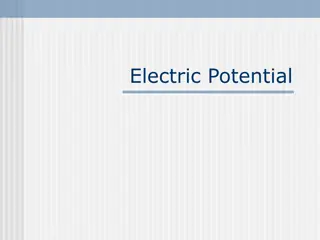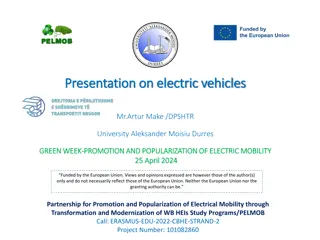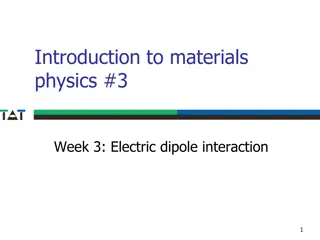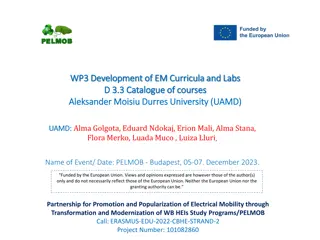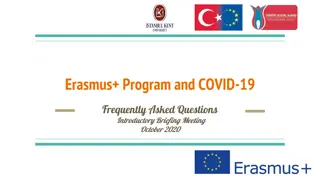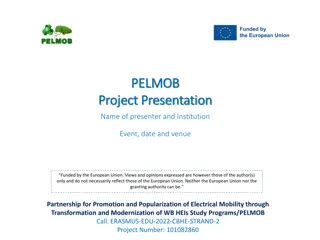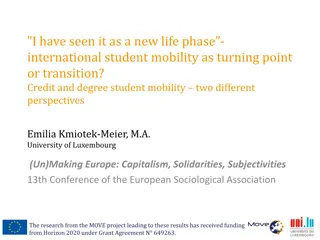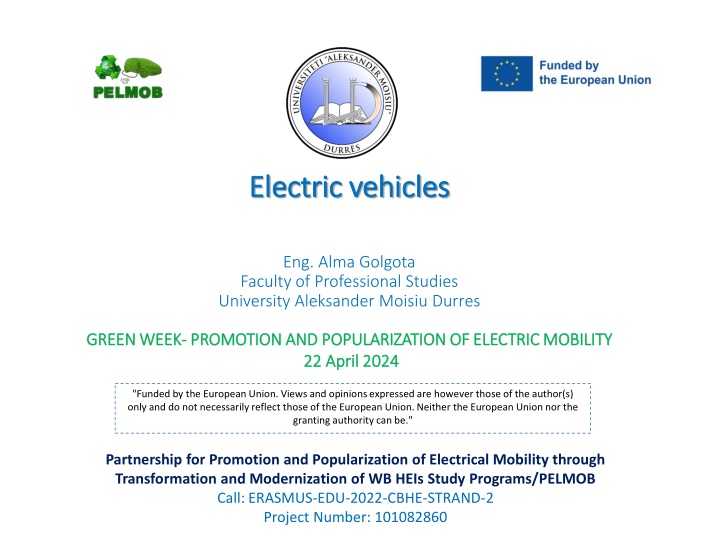
Promotion and Popularization of Electric Mobility through Partnership for Transformation and Modernization
Electric vehicles offer numerous advantages including environmental benefits, cost savings, and improved performance. Government incentives and policies are driving global adoption, while manufacturers like Tesla and Nissan lead the way with popular models. Explore the challenges, future trends, and overall impact of electric vehicles on the transportation sector. Learn more about this initiative funded by the European Union to promote electrical mobility in higher education institutions.
Download Presentation

Please find below an Image/Link to download the presentation.
The content on the website is provided AS IS for your information and personal use only. It may not be sold, licensed, or shared on other websites without obtaining consent from the author. If you encounter any issues during the download, it is possible that the publisher has removed the file from their server.
You are allowed to download the files provided on this website for personal or commercial use, subject to the condition that they are used lawfully. All files are the property of their respective owners.
The content on the website is provided AS IS for your information and personal use only. It may not be sold, licensed, or shared on other websites without obtaining consent from the author.
E N D
Presentation Transcript
Electric vehicles Electric vehicles Eng. Alma Golgota Faculty of Professional Studies University Aleksander Moisiu Durres GREEN WEEK GREEN WEEK- - PROMOTION AND POPULARIZATION OF ELECTRIC MOBILITY PROMOTION AND POPULARIZATION OF ELECTRIC MOBILITY 22 April 2024 22 April 2024 "Funded by the European Union. Views and opinions expressed are however those of the author(s) only and do not necessarily reflect those of the European Union. Neither the European Union nor the granting authority can be." Partnership for Promotion and Popularization of Electrical Mobility through Transformation and Modernization of WB HEIs Study Programs/PELMOB Call: ERASMUS-EDU-2022-CBHE-STRAND-2 Project Number: 101082860
Program: ERASMUS-EDU-2022-CBHE-STRAND-2 Project number: 101082860 INTRODUCTION 1. Electric Vehicle Models and Manufacturers 2. Advantages of Electric Vehicles 3. Government Incentives 4. Challenges and Barriers 5. Global Adoption and Market Trends 6. Environmental Impact 7. Government Policies and Incentives 8. Future Trends in Electric Vehicles 9. Conclusion Partnership for Promotion and Popularization of Electrical Mobility through Transformation and Modernization of WB HEIs Study Programs / PELMOB
Program: ERASMUS-EDU-2022-CBHE-STRAND-2 Project number: 101082860 1. Electric Vehicle Models and Manufacturers Key Electric Vehicle Manufacturers Popular Electric Vehicle Models Tesla Nissan Chevrolet Hyundai/Kia Volkswagen Group BMV Ford Mercedes-Benz Porsche Audi Tesla Model 3 Nissan Leaf Chevrolet Bolt EV Hyundai Kona Electric Volkswagen ID.3 and ID.4 BMW i3 Partnership for Promotion and Popularization of Electrical Mobility through Transformation and Modernization of WB HEIs Study Programs / PELMOB
Program: ERASMUS-EDU-2022-CBHE-STRAND-2 Project number: 101082860 2.Advantages of Electric Vehicles Environmental Benefits Electric Vehicles produce zero tailpipe emissions, which significantly reduces their contribution to greenhouse gas emissions Electric Vehicles are quieter than traditional internal combustion engine vehicles, contributing to reduced noise pollution in cities and neighborhoods. Electric motors are more energy-efficient than internal combustion engines, resulting in less wasted energy and lower overall energy consumption. Cost Savings Electricity is typically cheaper than gasoline or diesel, leading to significant savings on fuel Electric Vehicles have fewer moving parts than traditional vehicles, which means less wear and tear and fewer components that require regular maintenance. This results in lower maintenance costs over the lifetime of the vehicle. Many governments offer tax incentives, rebates, or subsidies to promote electric vehicle adoption reducing the upfront cost of purchasing an electric Vehicle. Performance and Maintenance Electric motors deliver instant torque, providing quick acceleration and a responsive driving experience. This can make electric Vehicles feel more powerful and fun to drive. Electric Vehicles are known for their quiet and smooth operation. This enhances the driving experience and reduces noise pollution. Electric Vehicles have fewer components that require maintenance compared to traditional vehicles. There is no need for oil changes, and brake wear is reduced due to regenerative braking systems. Partnership for Promotion and Popularization of Electrical Mobility through Transformation and Modernization of WB HEIs Study Programs / PELMOB
Program: ERASMUS-EDU-2022-CBHE-STRAND-2 Project number: 101082860 3.Government Incentives Many governments offer tax credits to incentivize the purchase of electric Vehicles. Other governments provide direct subsidies or rebates to electric Vehicle buyers, further lowering the purchase price. In some regions, electric Vehicle owners are allowed to use high- occupancy vehicle (HOV) lanes, even when driving alone, which can reduce commute times. Some areas offer reduced registration fees for electric vehicles, making them more affordable to own. Partnership for Promotion and Popularization of Electrical Mobility through Transformation and Modernization of WB HEIs Study Programs / PELMOB
Program: ERASMUS-EDU-2022-CBHE-STRAND-2 Project number: 101082860 4.Challenges and Barriers a. Limited Range b. Charging Infrastructure- c. Higher Initial Costs d. Charging Time e. Battery Recycling and Disposal f. Disposal Concerns Partnership for Promotion and Popularization of Electrical Mobility through Transformation and Modernization of WB HEIs Study Programs / PELMOB
Program: ERASMUS-EDU-2022-CBHE-STRAND-2 Project number: 101082860 5.Global Adoption and Market Trends a. Adoption Rates Worldwide b. Market Growth and Projections Electric Vehicles have been steadily gaining market share globally. Adoption rates vary by region. European countries, particularly Norway, the Netherlands, and Sweden, have seen significant electric Vehicle adoption due to strong incentives and charging infrastructure. China is the world's largest market for electric Vehicles. The electric Vehicle market has experienced explosive growth in recent years. Advances in battery technology, such as higher energy density and faster charging, are expected to extend the driving range of electric Vehicles and reduce charging times. Automakers are diversifying their electric vehicle portfolios, offering a wider range of options from compact Vehicles to SUVs and luxury vehicles. Plug-in hybrid electric vehicles (PHEVs) are also gaining popularity as a transitional solution. Partnership for Promotion and Popularization of Electrical Mobility through Transformation and Modernization of WB HEIs Study Programs / PELMOB
Program: ERASMUS-EDU-2022-CBHE-STRAND-2 Project number: 101082860 6. Environmental Impact Reduction in Greenhouse Gas Emissions Unlike internal combustion engine vehicles, which burn fossil fuels and emit Vehiclebon dioxide (CO2), nitrogen oxides (NOx), and particulate matter, electric Vehicles run on electricity and release no direct emissions during operation. Electric Vehicles play a vital role in mitigating climate change by reducing CO2 emissions. Air Quality Improvement Electric Vehicles contribute to improved local air quality in urban areas. They do not emit pollutants such as NOx, particulate matter, or volatile organic compounds that are harmful to human health and can contribute to smog and respiratory problems. Electric Vehicles are quieter than traditional vehicles with internal combustion engines. Partnership for Promotion and Popularization of Electrical Mobility through Transformation and Modernization of WB HEIs Study Programs / PELMOB
Program: ERASMUS-EDU-2022-CBHE-STRAND-2 Project number: 101082860 7.Government Policies and Incentives Subsidies and Tax Credits Direct cash rebates, tax credits, or reduced vehicle registration fees help offset the higher upfront cost of electric Vehicles, making them more affordable for consumers. Some governments provide incentives to automakers to produce electric vehicles, including grants, loans, or tax incentives. These measures encourage manufacturers to invest in electric vehicle development and production. Governments may offer financial support for the installation of public and private charging infrastructure. Emission Standards Governments worldwide are implementing stringent emission standards for vehicles, including limits on Vehiclebon dioxide (CO2) emissions. Automakers must reduce the average emissions of their vehicle fleets, pushing them to produce more electric and low-emission vehicles. Partnership for Promotion and Popularization of Electrical Mobility through Transformation and Modernization of WB HEIs Study Programs / PELMOB
Program: ERASMUS-EDU-2022-CBHE-STRAND-2 Project number: 101082860 7.Government Policies and Incentives Infrastructure Investment by government Invest in the expansion of charging infrastructure, including the deployment of fast-charging stations along highways and in urban areas. This investment reduces range anxiety and encourages electric vehicle adoption. Support funding research and development in electric vehicle technology, including battery advancements, electric drivetrains, and charging solutions. Some governments electrify their own vehicle fleets and provide incentives for public agencies to adopt electric vehicles. This showcases the government's commitment to sustainability and serves as a model for other organizations. Governments often run public awareness campaigns to educate consumers about the benefits of electric Vehicles and to dispel common misconceptions. Partnership for Promotion and Popularization of Electrical Mobility through Transformation and Modernization of WB HEIs Study Programs / PELMOB
Program: ERASMUS-EDU-2022-CBHE-STRAND-2 Project number: 101082860 8.Future Trends in Electric Vehicles Continued advancements in battery technology are expected to increase energy density, reducing the size and weight of batteries while extending the range of electric Vehicle Solid-state batteries, which promise higher energy density, faster charging, and improved safety, are a major focus of research and development. Ongoing efforts to enhance the efficiency of electric drive trains, power electronics, and regenerative braking systems Wireless charging technology is evolving, making it more convenient for electric Vehicle owners The use of lightweight and high-strength materials, such as Vehiclebon fiber and advanced composites, will help improve the energy efficiency and performance of electric Vehicles. Technological Advancements Electric Vehicles are well-suited for autonomous driving due to their compatibility with advanced sensor and computing systems. Autonomous electric Vehicles are likely to play a significant role in the future of ride-sharing and mobility-as-a-service (MaaS) platforms, providing convenient and eco-friendly transportation options. Companies may establish fleets of electric, autonomous vehicles for various applications, including last-mile delivery, public transportation, and on-demand mobility services. Autonomous EVs may have the capability to navigate to charging stations independently, optimizing their uptime and reducing range anxiety. Autonomous ElectricVehicles Automakers are increasingly using recycled and sustainable materials in the construction of electric Vehicles. This includes recycled plastics, sustainable textiles, and eco-friendly interior components. Electric Vehicle manufacturers are adopting environmentally friendly production methods, reducing waste, and minimizing the Vehiclebon footprint of the manufacturing process. Some companies are exploring closed-loop recycling systems for electric vehicle batteries, ensuring that materials are efficiently reused and recycled at the end of their life cycle. Electric Vehicle manufacturing plants are transitioning to renewable energy sources and employing energy-efficient technologies to minimize their environmental impact. Automakers are exploring circular economy models, where the entire life cycle of an electric Vehicle, from production to disposal, is designed to minimize waste and maximize sustainability. Sustainable Materials and Manufacturing Partnership for Promotion and Popularization of Electrical Mobility through Transformation and Modernization of WB HEIs Study Programs / PELMOB
Program: ERASMUS-EDU-2022-CBHE-STRAND-2 Project number: 101082860 8.Future Trends in Electric Vehicles Future Outlook for Electric Vehicles The future for electric Vehicles is promising, with continuous technological innovation expected to make them more accessible, efficient, and sustainable. Electric Vehicle adoption is likely to accelerate as battery technology improves, charging infrastructure expands, and government commitments to clean energy and transportation grow. The transition to electric Vehicles aligns with global efforts to combat climate change and reduce dependence on fossil fuels. Partnership for Promotion and Popularization of Electrical Mobility through Transformation and Modernization of WB HEIs Study Programs / PELMOB
Program: ERASMUS-EDU-2022-CBHE-STRAND-2 Project number: 101082860 8.Future Trends in Electric Vehicles Encouragement for Adoption and Sustainability Consumers are encouraged to consider electric Vehicles as a cleaner and more sustainable transportation option. Supportive government policies and incentives, as well as continued investment in charging infrastructure, are vital for accelerating electric Vehicle adoption. Sustainable practices, including recycling and responsible disposal of batteries, should be embraced to maximize the environmental benefits of electric Vehicles. The adoption of electric Vehicles contributes to a greener and more sustainable future, benefiting both individuals and the planet. Partnership for Promotion and Popularization of Electrical Mobility through Transformation and Modernization of WB HEIs Study Programs / PELMOB
Program: ERASMUS-EDU-2022-CBHE-STRAND-2 Project number: 101082860 9.Conclusions Future Outlook for Electric Vehicles Electric Vehicles offer numerous advantages, including reduced greenhouse gas emissions, cost savings, and superior performance. Challenges like limited range, charging infrastructure, and higher initial costs exist but are being addressed through technological advancements and government incentives. Government policies and incentives, including subsidies, emission standards, and infrastructure investment, are crucial drivers of electric Vehicle adoption. Electric Vehicles have a positive environmental impact, reducing emissions and improving air quality. Future trends include technological advancements, autonomous electric vehicles, and sustainable materials and manufacturing practices. Partnership for Promotion and Popularization of Electrical Mobility through Transformation and Modernization of WB HEIs Study Programs / PELMOB
Program: ERASMUS-EDU-2022-CBHE-STRAND-2 Project number: 101082860 THANK YOU! Partnership for Promotion and Popularization of Electrical Mobility through Transformation and Modernization of WB HEIs Study Programs / PELMOB







